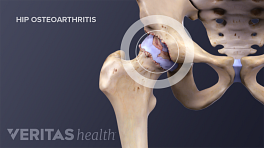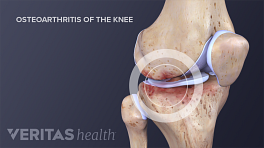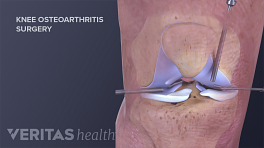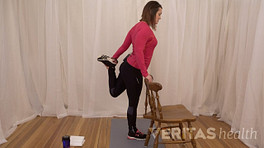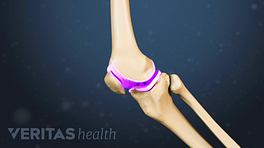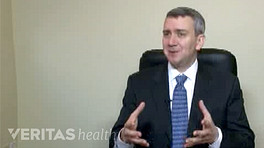While knee osteoarthritis may affect as many as 45% of people at some point in their lifetimes, 1 Murphy LB, et al. Lifetime risk of symptomatic knee osteoarthritis. Arthritis Rheum. 2008 Sep 15;59(9):1207-13, as cited in Arthritis by the Numbers: The Trusted Book of Facts and Figures 2018; v2. Arthritis Foundation. https://www.arthritis.org/Documents/Sections/About-Arthritis/arthritis-facts-stats-figures.pdf Accessed June 20, 2019. no one knows the exact cause. Experts do know that several risk factors increase the likelihood of developing knee arthritis.
In This Article:
Advanced age
The likelihood of developing knee arthritis increases with age. Over time, the knees‘ cartilage becomes weaker and less flexible, making it more prone to thinning and damage. In fact, research suggests
2
Zhang, Y., and J. M. Jordan. Epidemiology of osteoarthritis. Clin. Geriatr. Med. 26:355–369, 2010. As cited in Gardiner BS, Woodhouse FG, Besier TF, et al. Predicting Knee Osteoarthritis. Ann Biomed Eng. 2016;44(1):222–233. doi:10.1007/s10439-015-1393-5.
that 19% of people over 45 years old and 37% of those over 60 have knee arthritis that can be seen on an x-ray (though not all will have symptoms).
Obesity
Knees are weight-bearing joints, and a person who is obese is twice as likely to develop knee osteoarthritis than someone who is not.
3
Losina E, Weinstein AM, Reichmann WM, et al. Lifetime risk and age at diagnosis of symptomatic knee osteoarthritis in the US. Arthritis Care Res (Hoboken). 2013;65(5):703–711. doi:10.1002/acr.21898.
In addition, obesity is associated with low-grade, systemic (body-wide) inflammation, which may contribute to the development of osteoarthritis.
4
Sartori-Cintra AR, Aikawa P, Cintra DE. Obesity versus osteoarthritis: beyond the mechanical overload. Einstein (Sao Paulo). 2014;12(3):374–379. doi:10.1590/S1679-45082014RB2912.
,
5
Rosen, CJ, "Pathogenic mechanisms of obesity-induced osteoarthritis: new clues from old joints." Osteoarthritis and Cartilage (2019), doi:10.1016/j.joca.2019.02.007; Phone interview, June 10, 2019.
(Obesity is defined as a BMI ≥ 30.)
See How Effective is Weight Loss for Treating Knee Arthritis Pain?
Joint trauma
A broken bone, serious injury, or surgery may cause damage to the knee joint that eventually leads to knee osteoarthritis. The symptoms may not appear until many years after the injury. Osteoarthritis that develops as a result of previous injury is sometimes called post-traumatic arthritis.
See 6 Types of Arthritis that Affect the Knee
Family history
Similar to height and hair color, the likelihood of a person developing knee osteoarthritis is influenced by genetics. A woman whose mother has knee osteoarthritis is more likely to develop the condition than another woman whose mother did not have the knee osteoarthritis. While the exact extent of genetic factors is not known, experts estimate between 40% to 65% of knee arthritis cases may be influenced by genetics.
6
Spector TD, MacGregor AJ. Risk factors for osteoarthritis: genetics. Osteoarthritis and cartilage/OARS, Osteoarthritis Research Society. 2004;12(Suppl A):S39–44. PubMed PMID: 14698640.
,
7
Yucesoy B, Charles LE, Baker B, Burchfiel CM. Occupational and genetic risk factors for osteoarthritis: a review. Work. 2015;50(2):261–273. doi:10.3233/WOR-131739.
Illness or congenital defect
Episodes of gout or septic arthritis as well as metabolic disorders, poor bone alignment, and congenital conditions can increase the risk of developing osteoarthritis of the knee.
Joint stress and chronic injury
People whose regular activities or jobs require spending a lot of time on their feet; doing heavy lifting while standing; squatting; or crawling (e.g. installing carpets) can experience “mini-traumas” in their knee joints. Over time, mini-traumas can lead to the development of osteoarthritis. Athletes who participate in high-impact sports, such as basketball or tennis, may also be more prone to developing knee osteoarthritis.
Lack of exercise
While too much stress on the knee joint can cause arthritis, so can too little stress on the joint. The knee joint cartilage must be exposed to weight-bearing stress to encourage cartilage health and repair.
8
Gardiner BS, Woodhouse FG, Besier TF, et al. Predicting Knee Osteoarthritis. Ann Biomed Eng. 2016;44(1):222–233. doi:10.1007/s10439-015-1393-5.
The knee joint contains fluid, full of nutrients, and meant to be circulated throughout the knee joint capsule. Movement facilitates the circulation of joint fluid throughout the knee joint.
See Knee Exercises for Arthritis
Poor muscle tone
When hamstring, quadriceps, and calf muscles are weak, more stress is put on the knee cartilage and underlying bone. This stress can lead to knee osteoarthritis.
See Knee Strengthening Exercises
Female sex
Experts estimate women are about 40% more likely than men to develop osteoarthritis in the knee.
3
Losina E, Weinstein AM, Reichmann WM, et al. Lifetime risk and age at diagnosis of symptomatic knee osteoarthritis in the US. Arthritis Care Res (Hoboken). 2013;65(5):703–711. doi:10.1002/acr.21898.
Biochemical changes in the knee
Research has identified certain biochemical changes that occur in knee joints affected by osteoarthritis.
9
Van Spil WE, Nair SC, Kinds MB, Emans PJ, Hilberdink WK, Welsing PM, Lafeber FP. Systemic biochemical markers of joint metabolism and inflammation in relation to radiographic parameters and pain of the knee: data from CHECK, a cohort of early-osteoarthritis subjects. Osteoarthritis Cartilage. 2015 Jan;23(1):48-56. doi: 10.1016/j.joca.2014.09.003. Epub 2014 Sep 6. PubMed PMID: 25205017.
It is not clear if these changes are a cause or effect of the osteoarthritis process.
The two chief risk factors of knee osteoarthritis are advanced age and obesity.
While the above risks factors can increase the chances of developing knee osteoarthritis, they are not absolute. It is possible for a person with only one risk factor to develop knee osteoarthritis, while another person with several risk factors never develops it.- 1 Murphy LB, et al. Lifetime risk of symptomatic knee osteoarthritis. Arthritis Rheum. 2008 Sep 15;59(9):1207-13, as cited in Arthritis by the Numbers: The Trusted Book of Facts and Figures 2018; v2. Arthritis Foundation. https://www.arthritis.org/Documents/Sections/About-Arthritis/arthritis-facts-stats-figures.pdf Accessed June 20, 2019.
- 2 Zhang, Y., and J. M. Jordan. Epidemiology of osteoarthritis. Clin. Geriatr. Med. 26:355–369, 2010. As cited in Gardiner BS, Woodhouse FG, Besier TF, et al. Predicting Knee Osteoarthritis. Ann Biomed Eng. 2016;44(1):222–233. doi:10.1007/s10439-015-1393-5.
- 3 Losina E, Weinstein AM, Reichmann WM, et al. Lifetime risk and age at diagnosis of symptomatic knee osteoarthritis in the US. Arthritis Care Res (Hoboken). 2013;65(5):703–711. doi:10.1002/acr.21898.
- 4 Sartori-Cintra AR, Aikawa P, Cintra DE. Obesity versus osteoarthritis: beyond the mechanical overload. Einstein (Sao Paulo). 2014;12(3):374–379. doi:10.1590/S1679-45082014RB2912.
- 5 Rosen, CJ, "Pathogenic mechanisms of obesity-induced osteoarthritis: new clues from old joints." Osteoarthritis and Cartilage (2019), doi:10.1016/j.joca.2019.02.007; Phone interview, June 10, 2019.
- 6 Spector TD, MacGregor AJ. Risk factors for osteoarthritis: genetics. Osteoarthritis and cartilage/OARS, Osteoarthritis Research Society. 2004;12(Suppl A):S39–44. PubMed PMID: 14698640.
- 7 Yucesoy B, Charles LE, Baker B, Burchfiel CM. Occupational and genetic risk factors for osteoarthritis: a review. Work. 2015;50(2):261–273. doi:10.3233/WOR-131739.
- 8 Gardiner BS, Woodhouse FG, Besier TF, et al. Predicting Knee Osteoarthritis. Ann Biomed Eng. 2016;44(1):222–233. doi:10.1007/s10439-015-1393-5.
- 9 Van Spil WE, Nair SC, Kinds MB, Emans PJ, Hilberdink WK, Welsing PM, Lafeber FP. Systemic biochemical markers of joint metabolism and inflammation in relation to radiographic parameters and pain of the knee: data from CHECK, a cohort of early-osteoarthritis subjects. Osteoarthritis Cartilage. 2015 Jan;23(1):48-56. doi: 10.1016/j.joca.2014.09.003. Epub 2014 Sep 6. PubMed PMID: 25205017.


